Market Trends of Malaysia Renewable Energy Industry
Solar Photovoltaic (PV) to Dominate the Market
- Solar PV is poised to dominate the renewable energy landscape in Malaysia due to several key factors. First and foremost, Malaysia enjoys abundant solar resources due to its location near the equator and high levels of sunlight throughout the year. This natural advantage provides a strong foundation for solar PV installations, making it a highly viable renewable energy option. The declining costs of solar PV technology have significantly improved its cost competitiveness, making it increasingly attractive for investors and energy consumers.
- The Malaysian government has implemented supportive policies and incentives to foster solar energy development. Programs like Net Energy Metering (NEM) allow consumers to install solar PV systems and sell excess electricity back to the grid. At the same time, feed-in tariffs and tax incentives encourage investment in solar PV projects.
- For instance, in October 2022, the Malaysian government decided to extend the duration of power purchase agreements for large-scale photovoltaic (PV) projects under the fourth LSS4 tender. The original period of 21 years was increased to 25 years. The LSS4 program successfully allocated a total capacity of 823.06 MW across 30 projects. Overall, the program has awarded 2,457 MW of capacity, but as of June 2022, only 1,160 MW of that capacity was operational.
- Technological advancements have also played a crucial role in the prominence of solar PV. The industry has witnessed significant improvements in solar panel efficiency and overall performance, driving down costs and enhancing power generation capabilities.
- According to the International Renewable Energy Agency, the installed capacity of solar photovoltaics in the country increased by more than 8% between 2021 and 2022, signifying the increasing adoption of solar photovoltaics in the country.
- Therefore, based on the factors above, the utility sector is expected to dominate the Malaysian renewable energy market during the forecast period.

Supportive Government Policies to Drive the Market
- Government policies play a pivotal role in driving the renewable energy market in Malaysia. The government has implemented various policy measures to stimulate the growth of renewable energy, including the establishment of feed-in tariffs and power purchase agreements that provide stable and long-term contracts for renewable energy producers, encouraging investment in the sector. Setting ambitious renewable energy targets provides a clear direction and incentive for investors to participate in the market.
- Malaysia has set a target to derive 20% of its energy from renewable sources by 2025. The country will require an investment of approximately USD 8 billion in its renewable energy sector to achieve this goal. The expected investments are anticipated to come from a combination of government funding, public-private partnerships, and private financing.
- The government intends to encourage private financing and enhance private participation in the renewable energy sector. In addition to the ongoing government incentives like the Green Technology Financing Scheme, the Green Investment Tax Allowance, and the Green Income Tax Exemption, the emphasis will be on implementing institutional reforms to support the growth of renewable energy further.
- According to the International Renewable Energy Agency, the installed capacity of renewable energy in the country increased significantly between 2018 and 2022. The growth rate during this period was recorded at more than 20%, signifying healthy growth of renewables in the region.
- A supportive regulatory framework with streamlined permitting processes has also reduced barriers and bureaucratic hurdles for developers, facilitating the development of renewable energy projects.
- For instance, in March 2023, the 10 MWAC Solar Project in Labuan, Sabah, Malaysia, achieved financial close through Solar PV Power Sdn Bhd (SPP). SPP is a joint venture between Jetama Energy Sdn Bhd (Jetama) and Symbior Solar Limited (Symbior).
- Therefore, supportive government policies and initiatives are expected to drive the share of solar and renewable energy.

